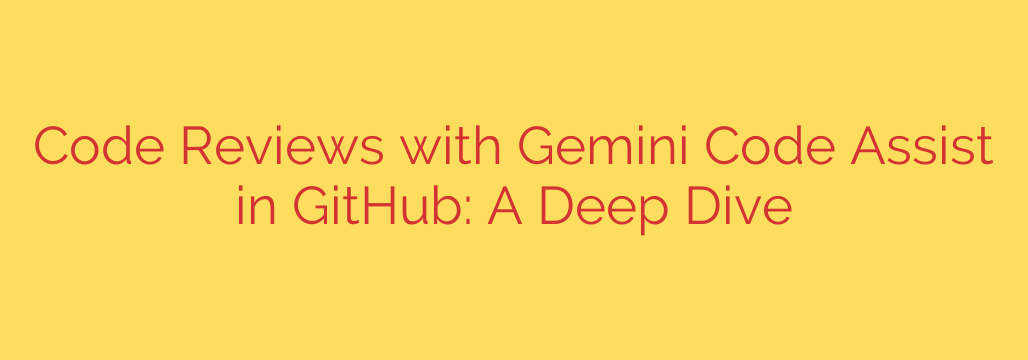
Revolutionize Your Code Review Process with AI: A Developer’s Guide
Let’s face it: code reviews are essential, but they can be a major bottleneck. They are critical for maintaining code quality, catching bugs, and mentoring junior developers. However, the manual process is often time-consuming, prone to human error, and can pull senior developers away from other critical tasks.
What if you could automate the most tedious parts of a code review, allowing your team to focus on what truly matters—logic, architecture, and innovation? This is where AI-powered developer tools are changing the game, integrating directly into familiar platforms like GitHub to create a smarter, faster, and more secure development workflow.
The Challenge with Traditional Code Reviews
The modern development lifecycle is built on speed and collaboration, but the code review process can often feel like a speed bump. Developers face context switching when they have to pause their work to review a colleague’s pull request (PR). For large or complex PRs, it can take a significant amount of time just to understand the scope of the changes before a proper review can even begin.
This manual effort can lead to several common problems:
- Reviewer Fatigue: After reviewing hundreds of lines, it’s easy to miss subtle bugs or style inconsistencies.
- Inconsistent Feedback: Different reviewers may focus on different things, leading to inconsistent standards across the codebase.
- Knowledge Gaps: A reviewer may not be an expert in a particular area of the code, making it difficult to spot potential security vulnerabilities or performance issues.
How AI Assistants Supercharge GitHub Workflows
AI assistants are now being integrated directly into the code review process within platforms like GitHub. Instead of relying solely on human eyes, these tools act as an intelligent partner, providing instant analysis and context for every pull request.
When a developer opens a PR, the AI can automatically generate a detailed summary of the changes in plain language. This is a massive time-saver, as it allows reviewers to grasp the purpose and scope of the changes without having to manually sift through every file.
The AI goes beyond simple summaries. It can perform a “pre-review” by analyzing the code for potential issues, offering suggestions, and even generating code comments to explain complex sections. This allows the human reviewer to focus their attention on higher-level concerns.
Key Benefits of AI-Assisted Code Reviews
Integrating AI into your review process offers a powerful set of advantages that can transform your team’s productivity and the quality of your final product.
Drastically Improved Developer Productivity: By automating the initial analysis and summary of a pull request, developers spend less time on manual reviews and more time on creative problem-solving and coding. The AI handles the “first pass,” freeing up valuable engineering hours.
Enhanced Code Quality and Consistency: AI assistants are tireless. They can be configured to enforce coding standards, style guides, and best practices with perfect consistency across every single pull request. This leads to a cleaner, more maintainable codebase over time.
Accelerated Learning and Onboarding: For junior developers, AI-powered feedback is like having a senior developer on call 24/7. The instant suggestions for improvement, bug fixes, and best practices provide an invaluable learning opportunity, helping them ramp up faster.
A Stronger, More Proactive Security Posture: Security is no longer an afterthought. AI tools can proactively scan code for common vulnerabilities, insecure patterns, and potential exploits before they are ever merged into the main branch. This shifts security left, making it an integral part of the development process.
Actionable Tips for Integrating AI into Your Workflow
While AI is a powerful ally, it’s most effective when used as a tool to augment, not replace, human expertise. The goal is to build a collaborative process between the developer, the AI, and the human reviewer.
Trust, but Verify: Always treat AI suggestions as expert advice, not infallible commands. The AI is fantastic at spotting patterns and known vulnerabilities, but a human reviewer is still needed to validate the business logic and architectural integrity of the changes.
Focus Human Reviews on the “Why”: Let the AI handle the “what” (identifying changes, checking syntax, finding simple bugs). This allows the human reviewer to concentrate on the “why.” Does this change solve the right problem? Does it fit within the long-term vision for the product? Is the chosen architecture sound?
Use AI for Better Documentation: If the AI generates a particularly good explanation of a complex function, encourage developers to incorporate that explanation into the official code comments or documentation. This improves the long-term health and maintainability of the codebase for everyone.
The future of software development is collaborative—not just between humans, but between humans and intelligent systems. By embracing AI-assisted code reviews, development teams can ship better, more secure code faster than ever before, turning a once-dreaded chore into a strategic advantage.
Source: https://cloud.google.com/blog/products/ai-machine-learning/gemini-code-assist-and-github-ai-code-reviews/








